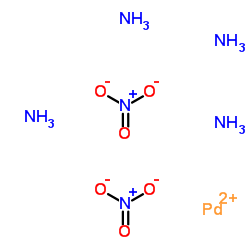Palladium(2+) nitrate ammoniate (1:2:4)

Palladium(2+) nitrate ammoniate (1:2:4) structure
|
Common Name | Palladium(2+) nitrate ammoniate (1:2:4) | ||
|---|---|---|---|---|
| CAS Number | 13601-08-6 | Molecular Weight | 298.552 | |
| Density | 1.04 g/mL at 25 °C | Boiling Point | 83ºC at 760 mmHg | |
| Molecular Formula | H12N6O6Pd | Melting Point | N/A | |
| MSDS | Chinese | Flash Point | N/A | |
| Symbol |


GHS03, GHS07 |
Signal Word | Danger | |
|
Block by ruthenium red of the ryanodine-activated calcium release channel of skeletal muscle.
J. Gen. Physiol. 102(6) , 1031-56, (1993) The effects of ruthenium red and the related compounds tetraamine palladium (4APd) and tetraamine platinum (4APt) were studied on the ryanodine activated Ca2+ release channel reconstituted in planar bilayers with the immunoaffinity purified ryanodine receptor... |
|
|
Tetramine dichloro-palladium subcellular localization in the kidney: electron microprobe study.
J. Submicrosc. Cytol. 19(1) , 53-6, (1987) Palladium salt has been used for some time in experimental therapy protocols; with this in mind, we carried out a study of the effect of tetramine dichloro-palladium (soluble salt) upon kidney cells. Using an electron microprobe, we were able to detect the pr... |
|
|
Aramendia, Maria A.; et al.
J. Catal. 209(2) , 413-416, (2002)
|
|
|
Direct synthesis of propylene oxide with CO2 as the solvent.
Angew. Chem. Int. Ed. Engl. 42 , 1140, (2003) Many plants attract their pollinators with floral scents, and these olfactory signals are especially important at night, when visual signals become inefficient. Dynastid scarab beetles are a speciose group of night-active pollinators, and several plants polli... |